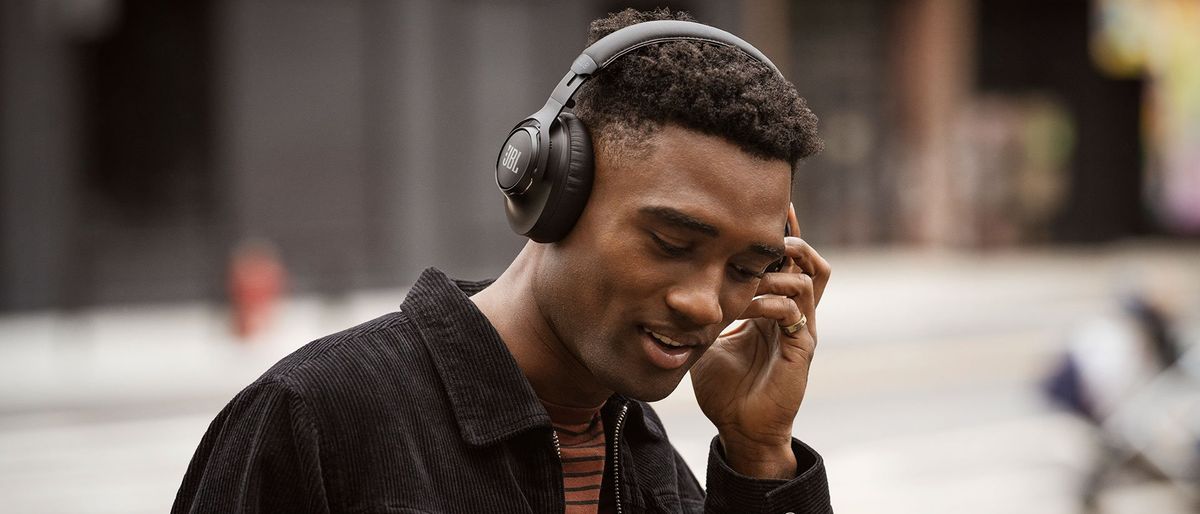TechRadar Verdict
As far as looks, build, features and sound quality go, the JBL Club One have very little to find fault in. If you want an alternative to Bose and Sony's flagship cans, the JBL Club One should be one of the pairs you listen to.
Pros
- +
Comfortable
- +
Impressive ANC
- +
Energetic sound
Cons
- -
Lackluster highs
- -
Woeful EQ presets
- -
Tough competition
Why you can trust TechRadar
30-second review
If you compiled a list of every pair of wireless active noise-cancelling headphones by every brand currently building them, what you’d end up with wouldn’t be a list so much as a directory. You can’t move for them, can you?
And it can be hard to stand out in a crowd when the market-place is as crowded as this. Even a company with the history, the legacy and the cachet of JBL has had problems making a dent on the wireless active noise-cancelling over-ear headphones market. But, undeterred, JBL is back with its ‘Club’ range - and leading the assault is the JBL Club One.
As far as looks, feel, build quality and specification go, the Club One seems about as serious and determined an attempt to impose itself on this market as JBL has ever mustered. But when you’re going up against the likes of Bose, Bowers & Wilkins, Sennheiser and Sony, ticking those four boxes is just the tip of the iceberg...
Price and release date
JBL debuted the Club One at CES 2020, and released them to the world in the first half of 2020. In terms of price, you're looking at £300 / $350 / AU$500, which puts them directly against the Sony WH-1000XM3 and Bose NC 700.
How do they stack up? Well, Sony’s universally admired WH-1000XM3s remains the one to beat - and with rumors of the imminent Sony WH-1000XM4 getting louder and louder, there may well be XM3 deals to be had. And it’s equally worthwhile checking out Bose’s elegant Noise Cancelling Headphones 700 - it’s pricier, yes, and no more enjoyable in musical terms, but its nose-cancelling is phenomenal. Plus it’s the best-looking pair of headphones Bose has turned out in ages.
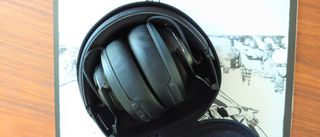
Design
Considering how little scope there is to fiddle with the basic design of over-ear headphones, JBL has done well to make the Club One as discreetly distinctive as it has. If you can call a black-on-black colorway ‘distinctive’, anyhow.
Despite a fairly porky 379g weight, the Club One is comfortable to wear - even for extended periods. A lot of that is down the well-judged padding of the leather-covered headband and the equally judicious balance of leather and memory foam that make up the earpads. The ‘pads are attached to plastic earcups, which feel robust and resist fingerprint marks well - they use metal yokes (which have just a little forward/backward articulation) to attach to the headband.
The headband itself is equally black and equally metallic, and the sliding action that helps them get a good fit on your head feels more than sturdy enough. When not in use, Club One can fold up almost into a ball for ease of transportation.
JBL has kept these metal elements nice and slender, which means there’s some braided cabling running from the top of each earcup into the headband – somehow this looks purposeful enough to give a little visual boost to the Club One’s ‘pro’ credentials. The bottom of each side of the headband has a plastic cap bearing the legend ‘CLUB’ in black, while the outside of each earcup features the ‘JBL’ logo in black too. There’s a narrow and stylised shiny silver ‘circle’ around each earcup too and, well, that’s about it. Compare this level of branding to JBL’s recent efforts in headphone design and the Club One, while strong lookers, are remarkably discreet.
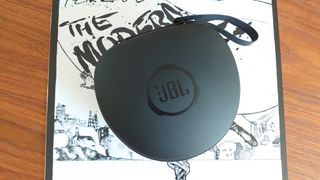
Along with the headphones themselves, the box contains a hard-ish travel case - Club One fold usefully small, and the case is nicely compact as a consequence. There’s also a USB-C cable for charging the 730mAh lithium-ion battery, a 1m 3.5mm-3.5mm cable with an in-line remote control plus mic and a coiled 1.5m 3.5mm-3.5mm cable too. Both cables can accept the 3.5mm-6.3mm adapter that’s provided. And completing a nap hand of connectivity, Club One comes complete with a flight adapter.
JBL is claiming a whopping 45 hours of wireless playback time, or 23 wireless hours if noise-cancelling is engaged. Use them with a cable and noise-cancelling on, and 25 hours should be yours. From flat to full should take a couple of hours, and a 15-minute charge should hold you for a couple of hours of playback time.
Features
As far as the ‘wireless’ aspect of Club One goes, JBL has specified Bluetooth 5.0 connectivity. This is more than enough to get the quite-important ‘Hi-Res Audio’ logo onto the packaging and, even more importantly, hi-res audio files into the headphones. If you subscribe to Tidal Masters, Qobuz Studio Premier or any of the other high-quality music streaming services, Club One should really make the most of it.
The Club One can accept multi-point Bluetooth connection, too. It’s possible to wirelessly pair two sources to the headphones at a time – although obviously it’s only possible to listen to one at a time.
Sound is delivered by a pair of 40mm graphene free-edge dynamic drivers. These, unusually, are visible in the earcups – they sit behind a metal grille which itself is behind a protective silk-like covering. Their dull orange finish adds a colorful bit of pizzazz to the Club One’s otherwise quite stern monochromatic color palette.
In terms of ‘active noise-cancelling’, JBL has managed to give itself a point of difference in comparison to competing designs by specifying and implementing an ‘adaptive’ system. Rather than offering degrees of noise-cancellation, Club One simply has ‘on’ or ‘off’ settings – but when noise-cancellation is ‘on’, the mic array monitors ambient conditions as often as 50,000 times per second and adjusts noise-cancellation accordingly. According to JBL, this system is sensitive enough to take things like hair- or glasses-movement into account. Owning neither glasses nor hair, we can only take the company’s word for it.
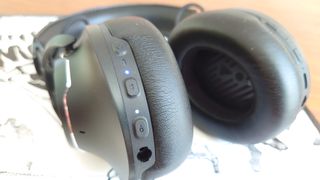
The edge of the right-hand earcup features a USB-C input, a 3.5mm analogue socket, and a rocker control governing volume up/down and play/pause. On the left-hand edge there’s power on/off, Bluetooth pairing, another 3.5mm analogue socket and a ‘smart ambient’ button that can either boost external sound (‘ambient aware’), drop the level of your music at the same time (‘talkthru’), or defeat the Bluetooth connection while maintaining noise-cancellation (‘silent now’).
In the centre of the left-hand earcup there’s a big, bold push/push button for summoning some voice assistance with support for both Amazon Alexa and Google Assistant.
So far, so pretty much par for the course - but the ‘My JBL Headphones’ app (Android and iOS) brings an impressive degree of customisation to the Club One experience. As well as the option to assign ‘ambient aware’ or ‘talkthru’ to the control button on the left-hand earcup, or to engage or disengage active noise-cancelling, there’s a lot of scope for EQ adjustment. It’s possible to set your of bespoke levels, or enjoy sound as tailored by five different DJs in the ‘DJ Signature’ section of the app.
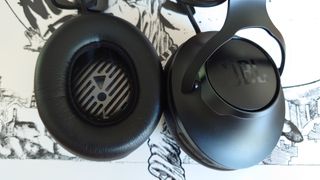
Performance
With all EQ adjustments defeated and a Tidal-derived 16bit/44.1kHz file of The Specials’ eponymous debut album playing, Club One doesn’t procrastinate. Without the headphones being in any way pushy about it, the recording is organised and explained unequivocally.
At the bottom of the frequency range there’s weight, momentum and texture. Bass guitar notes begin with straight-edged alacrity and decay just as promptly, so they underpin the recording without dragging at tempos or swamping the information above them. This combination of rapidity and substance is beyond quite a few rival headphone designs, but JBL has made Club One sound like brisk, detailed bass information is the most natural thing in the world.
A switch to Ella Fitzgerald’s Let’s Do It allows the JBLs to demonstrate similar surety where midrange fidelity is concerned. The purity of tone and effortless precision of Fitzgerald’s singing is described in full - the controlled vibrato, the tiny palate noises, even the breath-management is given a little space to make itself heard. There’s nothing uptight or analytical about the way Club One delivers the recording – the languid arrangement rolls along at its own speed – but nevertheless there’s a natural sort of immediacy to the presentation that’s very listenable.
Up at the top of the frequency range, Club One displays a rather polite level of attack to Antiguo Automata Mexicano’s Rother, Dinger, You and Me. Push the volume northwards and the JBLs can be provoked into some treble bite, but at more realistic levels there’s just about enough shine to balance out the robust low-end reproduction. Rolling off higher frequencies in this manner can make for an easier and more comfortable ride in the long term, but it doesn’t really help the tune drive forward in the manner it should.
A desire for a little more high-end positivity might send you into the EQ settings of the ‘My JBL Headphones’ app – and it’s certainly possible to add a little more top-end brilliance to the Club One sound without skewing the overall reproduction too badly.
With noise-cancelling engaged, there’s a definite reduction in external interference with very little of the ‘pressurisation’ sensation some alternative designs can introduce. But while the JBLs might well be analyzing your environmental circumstances thousands of times a second, Club One can’t entirely dismiss the noise of concentrated traffic or enraged seagulls. Mind you, very few headphones can handle The Seagull Test.
Final verdict
As far as looks, build, features and sound quality go, there’s very little to find fault with here. Sony’s WH-1000XM3 might have better sound quality thanks to the amount of high-end presence it delivers, but the JBL can compete across the board – even its adaptive noise-cancellation proves successful.
If you want an alternative to the ’me too!’ Bose and Sony default choices, the JBL Club One should be one of the pairs you listen to.
- These are a definite contender for our list of the best wireless headphones
Simon Lucas is a senior editorial professional with deep experience of print/digital publishing and the consumer electronics landscape. Based in Brighton, Simon worked at TechRadar's sister site What HiFi? for a number of years, as both a features editor and a digital editor, before embarking on a career in freelance consultancy, content creation, and journalism for some of the biggest brands and publications in the world.
With enormous expertise in all things home entertainment, Simon reviews everything from turntables to soundbars for TechRadar, and also likes to dip his toes into longform features and buying guides. His bylines include GQ, The Guardian, Hi-Fi+, Metro, The Observer, Pocket Lint, Shortlist, Stuff T3, Tom's Guide, Trusted Reviews, and more.
